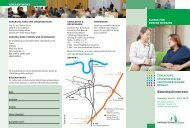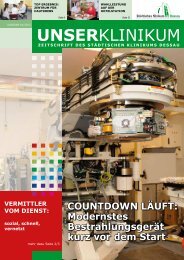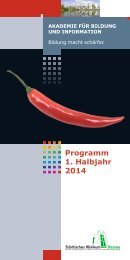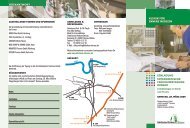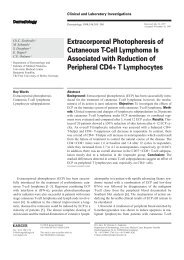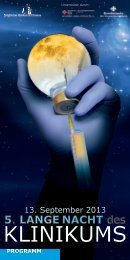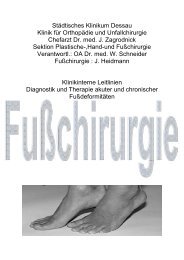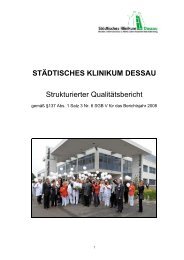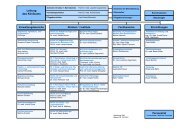Sebaceous Glands and the Prostaglandin PathwayâKey Stones of ...
Sebaceous Glands and the Prostaglandin PathwayâKey Stones of ...
Sebaceous Glands and the Prostaglandin PathwayâKey Stones of ...
You also want an ePaper? Increase the reach of your titles
YUMPU automatically turns print PDFs into web optimized ePapers that Google loves.
See related article on page 865<br />
<strong>Sebaceous</strong> <strong>Gl<strong>and</strong>s</strong> <strong>and</strong> <strong>the</strong> Prostagl<strong>and</strong>in Pathway—Key <strong>Stones</strong><br />
<strong>of</strong> an Exciting Mosaic<br />
Christos C. Zouboulis<br />
Department <strong>of</strong> Dermatology, Charité Universitaetsmedizin Berlin, Campus Benjamin Franklin, Berlin, Germany<br />
Prostagl<strong>and</strong>ins (PG) are detected in virtually all organs <strong>and</strong><br />
cells, whereas <strong>the</strong>ir enhanced release follows inflammatory<br />
mechanisms. PG syn<strong>the</strong>sis, especially <strong>of</strong> PGE 2 , PGD 2 <strong>and</strong><br />
PGF 2a , also takes place in epidermal keratinocytes as a<br />
result <strong>of</strong> arachidonic acid (AA) metabolism (Kondoh et al,<br />
1985; Pentl<strong>and</strong> <strong>and</strong> Needleman, 1986) <strong>and</strong> is differentially<br />
supported by specific enzymatic systems, <strong>the</strong> constitutively<br />
expressed cyclooxygenase (COX)-1 <strong>and</strong> <strong>the</strong> inducible COX-<br />
2 (Holtzman et al, 1994). Several mediators, such as phorbol<br />
myristate acetate, calcium ionophore A23187, melittin,<br />
bradykinin, epidermal growth factor, 1-oleoyl-2-acetyl glycerol<br />
platelet-activating factor (syn<strong>the</strong>tic analog <strong>of</strong> diacylglycerol),<br />
cholecalciferol, interleukin-1, <strong>and</strong> tumor growth<br />
factor-a have been shown to activate this pathway (Kondoh<br />
et al, 1985; Fairley et al, 1986; Kvedar <strong>and</strong> Levine, 1987;<br />
Fisher et al, 1989; Pentl<strong>and</strong> <strong>and</strong> Mahoney, 1990; Hanke<br />
et al, 1996; Kanekura et al, 1998). Exogenous PG regulate<br />
major keratinocyte functions, i.e., inhibit or stimulate proliferation<br />
in vitro under different culture conditions (Harper,<br />
1976; Sugita et al, 1986), modify cyclic nucleotide levels<br />
(Wilkinson <strong>and</strong> Orenberg, 1979), <strong>and</strong> enhance calcium-induced<br />
cornification (Evans et al, 1993). Endogenous PG<br />
have been shown to enhance keratinocyte proliferation<br />
(Pentl<strong>and</strong> <strong>and</strong> Needleman, 1986). On <strong>the</strong> o<strong>the</strong>r h<strong>and</strong>, fibroblasts<br />
are less responsive to PG pathway activators,<br />
whereas keratinocytes can activate fibroblasts to produce<br />
prostocyclin which is a paracrine prodifferentiating agent for<br />
keratinocytes (Baden et al, 1992).<br />
Despite <strong>the</strong> abundant knowledge on <strong>the</strong> PG pathway in<br />
keratinocytes, little is known on its activity in sebaceous<br />
gl<strong>and</strong> cells, which represent differentiated epi<strong>the</strong>lial cells.<br />
PG syn<strong>the</strong>sis, especially that <strong>of</strong> PGD 2 <strong>and</strong> PGE 2 , has been<br />
detected in mouse sebaceous gl<strong>and</strong> cells (Henke et al,<br />
1986). In 1998, Ma et al reported a major finding: estrogen<br />
treatment, which induces peroxisome proliferation in <strong>the</strong><br />
uropygial gl<strong>and</strong> in <strong>the</strong> duck, also enhanced AA metabolism<br />
in this organ. Conversion <strong>of</strong> PGD 2 to <strong>the</strong> natural PGJ 2 metabolite,<br />
D 12 -PGJ 2 , was induced by estradiol treatment preceding<br />
peroxisome proliferation. Exogenous D 12 -PGJ 2 <strong>and</strong><br />
15-deoxy-D 12,14 -PGJ 2 activated <strong>the</strong> peroxisome proliferators-activated<br />
receptor (PPAR)-g1, being, <strong>the</strong>refore, its natural<br />
lig<strong>and</strong>s. On <strong>the</strong> o<strong>the</strong>r h<strong>and</strong>, Neufang et al (2001) have<br />
shown that in a COX-2 overexpressing mouse, PG accumulation<br />
occurs, <strong>the</strong> skin exhibits a preneoplastic phenotype,<br />
<strong>and</strong> that sebaceous gl<strong>and</strong> hyperplasia, increased<br />
sebum levels, sparse coat <strong>of</strong> greasy hair, <strong>and</strong> hyperplasia <strong>of</strong><br />
scale epidermis due to a disturbed program <strong>of</strong> epidermal<br />
differentiation are present. These data confirmed previous<br />
results by Rosenfield et al (1998) that PPAR-g1 lig<strong>and</strong>s induce<br />
lipid accumulation in mouse preputial gl<strong>and</strong> cells<br />
in vitro. In addition, <strong>the</strong> latter group has shown that exogenous<br />
carbaprostacyclin (cPGI 2 ), stable prostocyclin analogue <strong>and</strong><br />
a natural PPAR-d/-a lig<strong>and</strong>, significantly induced lipid-forming<br />
colonies in mouse preputial gl<strong>and</strong> cells in vitro <strong>and</strong> that<br />
retinoid X receptor agonists amplified <strong>the</strong> effect <strong>of</strong> cPGI 2<br />
(Kim et al, 2001). Proliferation <strong>of</strong> <strong>the</strong> mouse preputial gl<strong>and</strong><br />
cells was also enhanced significantly by cPGI 2 . Interestingly,<br />
AA induces accumulation <strong>of</strong> lipids in human sebaceous<br />
gl<strong>and</strong> cells in vitro (Wróbel et al, 2003) <strong>and</strong> downregulation<br />
PPAR-a through selective lig<strong>and</strong>s has currently been suggested<br />
to be involved in <strong>the</strong> development <strong>of</strong> seborrhea <strong>and</strong><br />
acne (Zouboulis et al, 2003, 2005).<br />
In this issue, Iwata et al (2005) close <strong>the</strong> knowledge gap<br />
by providing evidence that 15-deoxy-D 12,14 -PGJ 2 augments<br />
<strong>the</strong> formation <strong>of</strong> lipid droplets in hamster auricle sebaceous<br />
gl<strong>and</strong> cells in vitro. This effect occurs due to a diacylglycerol<br />
acyltransferase-triggered increase <strong>of</strong> triacylglycerol syn<strong>the</strong>sis,<br />
which indicates sebaceous gl<strong>and</strong> cell differentiation,<br />
<strong>and</strong> is accompanied by an increase <strong>of</strong> <strong>the</strong> relative levels<br />
<strong>of</strong> 15-deoxy-D 12,14 -PGJ 2 to PGF 2a <strong>and</strong> PGE 2 . Hamster auricle<br />
sebaceous gl<strong>and</strong> cells were found to constitutively<br />
produce COX-2 but not COX-1, whereas human facial sebaceous<br />
gl<strong>and</strong> cells constitutively produce both COX-2<br />
<strong>and</strong> COX-1 (Alestas et al, in press). Although COX inhibition<br />
by indomethacin, dicl<strong>of</strong>enac or NS-398 led to an expected<br />
reduction <strong>of</strong> PGF 2a <strong>and</strong> PGE 2 production, syn<strong>the</strong>sis<br />
<strong>of</strong> 15-deoxy-D 12,14 -PGJ 2 increased, <strong>and</strong> triacylglycerol syn<strong>the</strong>sis<br />
was also enhanced. Triacylglycerol syn<strong>the</strong>sis was<br />
also enhanced in <strong>the</strong> presence <strong>of</strong> <strong>the</strong> PPAR-g1 lig<strong>and</strong> troglitazone.<br />
Similarly, topical administration <strong>of</strong> indomethacin to<br />
hamster auricles was found to cause <strong>the</strong> development <strong>of</strong><br />
sebaceous gl<strong>and</strong>s with <strong>the</strong> augmentation <strong>of</strong> sebum deposition<br />
in vivo. The indomethacim <strong>and</strong> NS-398-augmented<br />
15-deoxy-D 12,14 -PGJ 2 production <strong>and</strong> triacylglycerol syn<strong>the</strong>sis<br />
here suppressed by a nonselective cytochrome<br />
P-450 inhibitor, which did not affect <strong>the</strong> similar troglitazone<br />
effect.<br />
This fascinating work provides a number <strong>of</strong> links in underst<strong>and</strong>ing<br />
<strong>the</strong> biological role <strong>of</strong> <strong>the</strong> PG pathway in sebaceous<br />
gl<strong>and</strong> cells: a) COX-2 <strong>and</strong> a still unknown cytochrome<br />
P-450 enzyme—downstream to PGD synthase—exhibit opposite<br />
effects. Therefore, COX-2 inhibitors reduce PGF 2a<br />
Copyright r 2005 by The Society for Investigative Dermatology, Inc.<br />
x
125 : 5 NOVEMBER 2005<br />
SEBACEOUS AND PROSTAGLANDIN—MOSAIC<br />
xi<br />
<strong>and</strong> PGE 2 levels but increase 15-deoxy-D 12,14 -PGJ 2 production<br />
<strong>and</strong> triacylglycerol syn<strong>the</strong>sis. The clinical consequence<br />
could be that COX-2 inhibition may lead to a<br />
downregulation <strong>of</strong> an existing inflammatory reaction but<br />
may also enhance seborrhoea; <strong>and</strong> b) both natural <strong>and</strong><br />
syn<strong>the</strong>tic PPAR-g1 lig<strong>and</strong>s enhance lipid syn<strong>the</strong>sis in sebaceous<br />
gl<strong>and</strong> cells following different modes <strong>of</strong> action, which<br />
for <strong>the</strong> natural PPAR-g1 lig<strong>and</strong> 15-deoxy-D 12,14 -PGJ 2 is <strong>the</strong><br />
regulation <strong>of</strong> a cytochrome P-450 enzyme.<br />
In addition, <strong>the</strong> results <strong>of</strong> this study combined with <strong>the</strong><br />
results <strong>of</strong> <strong>the</strong> previous reports mentioned above give a partial<br />
explanation <strong>of</strong> <strong>the</strong> ra<strong>the</strong>r complex sebotropic effect <strong>of</strong> estrogens<br />
(Callens et al, 1996; Dieudonne et al, 2000). Estrogens<br />
seem to upregulate 15-deoxy-D 12,14 -PGJ 2 syn<strong>the</strong>sis <strong>and</strong> subsequently<br />
enhance PPAR-g1 activity <strong>and</strong> sebaceous lipid syn<strong>the</strong>sis<br />
(Ma et al, 1998; Iwata et al, 2005). This pathway <strong>of</strong><br />
estrogen effectiveness is probably complementary to estrogen’s<br />
capacity to upregulate <strong>the</strong> insulin-like growth factor-1<br />
pathway <strong>and</strong>, subsequently, production <strong>of</strong> sebaceous lipids<br />
(Makrantonaki et al, 2002; Mendez-Davila et al, 2004).<br />
At last, <strong>the</strong> work <strong>of</strong> Iwata et al (2005) provides indirect<br />
evidence that <strong>the</strong> inhibition <strong>of</strong> <strong>the</strong> lipoxygenase pathway,<br />
which exhibits proinflammatory <strong>and</strong> sebotropic activities<br />
<strong>and</strong> a possible regulation <strong>of</strong> PPAR-a (Alestas et al, in press;<br />
Zouboulis et al, 2003, 2005) is likely to be more powerful<br />
than <strong>the</strong> inhibition <strong>of</strong> <strong>the</strong> PG pathway, including PPAR-g1<br />
regulation, for future treatments <strong>of</strong> seborrhea <strong>and</strong> acne. On<br />
<strong>the</strong> o<strong>the</strong>r h<strong>and</strong>, manipulating <strong>the</strong> PG pathway may be <strong>of</strong><br />
great interest in improving <strong>the</strong> activity <strong>of</strong> aging sebaceous<br />
gl<strong>and</strong>s by parallel downregulation <strong>of</strong> inflammatory signals,<br />
thus improving <strong>the</strong> quality <strong>of</strong> aging skin.<br />
DOI: 10.1111/j.0022-202X.2005.23922.x<br />
References<br />
Alestas T, Gancevicience R, Fimmel S, Muller-Decker K, Zouboulis CC: Enzymes<br />
involved in <strong>the</strong> biosyn<strong>the</strong>sis <strong>of</strong> leukotriane B 4 <strong>and</strong> prostagl<strong>and</strong>in E 2 are<br />
active in sebaceous gl<strong>and</strong>s. J Mol Med, in press<br />
Baden HP, Goldaber ML, Kvedar JC: Keratinocytes stimulate prostagl<strong>and</strong>in I2<br />
syn<strong>the</strong>sis by 3T3 cells <strong>and</strong> exhibit enhanced cornification when exposed<br />
to prostagl<strong>and</strong>in I2 analogues. J Cell Physiol 150:269–275, 1992<br />
Callens A, Vaillant L, Lecomte P, Berson M, Gall Y, Lorette G: Does hormonal skin<br />
aging exist? A study <strong>of</strong> <strong>the</strong> influence <strong>of</strong> different hormone <strong>the</strong>rapy regimens<br />
on <strong>the</strong> skin <strong>of</strong> postmenopausal women using non-invasive measurement<br />
techniques. Dermatology 193:289–294, 1996<br />
Dieudonne MN, Pecquery R, Leneveu MC, Giudicelli Y: Opposite effects <strong>of</strong> <strong>and</strong>rogens<br />
<strong>and</strong> estrogens on adipogenesis in rat preadipocytes: Evidence<br />
for sex <strong>and</strong> site-related specificities <strong>and</strong> possible involvement <strong>of</strong> insulinlike<br />
growth factor 1 receptor <strong>and</strong> peroxisome proliferator-activated receptor<br />
gamma2. Endocrinology 141:649–656, 2000<br />
Evans CB, Pillai S, Goldyne ME: Endogenous prostagl<strong>and</strong>in E2 modulates calcium-induced<br />
differentiation in human skin keratinocytes. Prostagl<strong>and</strong>ins<br />
Leukot Essent Fatty Acids 49:777–781, 1993<br />
Fairley JA, Weiss J, Marcelo CL: Increased prostagl<strong>and</strong>in syn<strong>the</strong>sis by low calcium-regulated<br />
keratinocytes. J Invest Dermatol 86:173–176, 1986<br />
Fisher GJ, Talwar HS, Ryder NS, Voorhees JJ: Differential activation <strong>of</strong> human<br />
skin cells by platelet activating factor: Stimulation <strong>of</strong> phosphoinositide<br />
turnover <strong>and</strong> arachidonic acid mobilization in keratinocytes but not in<br />
fibroblasts. Biochem Biophys Res Commun 163:1344–1350, 1989<br />
Hanke B, Furstenberger G, Marks F: Relationship between TGF alpha-induced<br />
DNA syn<strong>the</strong>sis <strong>and</strong> prostagl<strong>and</strong>in syn<strong>the</strong>sis in human HaCaT keratinocytes.<br />
Biochim Biophys Acta 1310:137–144, 1996<br />
Harper RA: Effect <strong>of</strong> prostagl<strong>and</strong>ins on 3H-thymidine uptake into human epidermal<br />
cells in vitro. Prostagl<strong>and</strong>ins 12:1019–1025, 1976<br />
Henke D, Danilowicz R, Eling T: Arachidonic acid metabolism by isolated epidermal<br />
basal <strong>and</strong> differentiated keratinocytes from <strong>the</strong> hairless mouse.<br />
Biochim Biophys Acta 876:271–279, 1986<br />
Holtzman MJ, Zhang V, Hussain H, Roswit WT, Wilson JD: Prostagl<strong>and</strong>in H<br />
synthase <strong>and</strong> lipoxygenase gene families in <strong>the</strong> epi<strong>the</strong>lial cell barrier. Ann<br />
N Y Acad Sci 744:58–77, 1994<br />
Iwata C, Akimoto N, Sato T, Morokuma Y, Ito A: Augmentation <strong>of</strong> lipogenesis by<br />
15-deoxy-D 12,14 -prostagl<strong>and</strong>in J 2 in hamster sebaceous gl<strong>and</strong>s: Identification<br />
<strong>of</strong> cytochrome P450-mediated 15-deoxy-D 12,14 -prostagl<strong>and</strong>in J 2<br />
production. J Invest Dermatol 125:865–872, 2005<br />
Kanekura T, Laulederkind SJ, Kirtikara K, Goorha S, Ballou LR: Cholecalciferol<br />
induces prostagl<strong>and</strong>in E2 biosyn<strong>the</strong>sis <strong>and</strong> transglutaminase activity in<br />
human keratinocytes. J Invest Dermatol 111:634–639, 1998<br />
Kim MJ, Deplewski D, Ciletti N, Michel S, Reichert U, Rosenfield RL: Limited<br />
cooperation between peroxisome proliferator-activated receptors <strong>and</strong><br />
retinoid X receptor agonists in sebocyte growth <strong>and</strong> development. Mol<br />
Genet Metab 74:362–369, 2001<br />
Kondoh H, Sato Y, Kanoh H: Arachidonic acid metabolism in cultured mouse<br />
keratinocytes. J Invest Dermatol 85:64–69, 1985<br />
Kvedar J, Levine L: Modulation <strong>of</strong> arachidonic acid metabolism in a cultured<br />
newborn rat keratinocyte cell line. J Invest Dermatol 88:124–149, 1987<br />
Ma H, Sprecher HW, Kolattukudy PE: Estrogen-induced production <strong>of</strong> a peroxisome<br />
proliferator-activated receptor (PPAR) lig<strong>and</strong> in a PPARgamma-expressing<br />
tissue. J Biol Chem 273:30131–30138, 1998<br />
Makrantonaki E, Oeff MK, Fimmel S, Zouboulis CC: Estrogen activity on human<br />
skin involves interaction with <strong>the</strong> insulin-like growth factor-I signaling<br />
pathway. J Invest Dermatol 121:Abstract 0579, 2002<br />
Mendez-Davila C, Garcia-Moreno C, Turbi C, de la Piedra C: Effects <strong>of</strong> 17betaestradiol,<br />
tamoxifen <strong>and</strong> raloxifene on <strong>the</strong> protein <strong>and</strong> mRNA expression<br />
<strong>of</strong> interleukin-6, transforming growth factor-beta1 <strong>and</strong> insulin-like growth<br />
factor-1 in primary human osteoblast cultures. J Endocrinol Invest<br />
27:904–912, 2004<br />
Neufang G, Furstenberger G, Heidt M, Marks F, Müller-Decker K: Abnormal differentiation<br />
<strong>of</strong> epidermis in transgenic mice constitutively expressing<br />
cyclooxygenase-2 in skin. Proc Natl Acad Sci USA 98:7629–7634, 2001<br />
Pentl<strong>and</strong> AP, Mahoney MG: Keratinocyte prostagl<strong>and</strong>in syn<strong>the</strong>sis is enhanced by<br />
IL-1. J Invest Dermatol 94:43–46, 1990<br />
Pentl<strong>and</strong> AP, Needleman P: Modulation <strong>of</strong> keratinocyte proliferation in vitro by<br />
endogenous prostagl<strong>and</strong>in syn<strong>the</strong>sis. J Clin Invest 77:246–251, 1986<br />
Rosenfield RL, Deplewski D, Kentsis A, Ciletti N: Mechanisms <strong>of</strong> <strong>and</strong>rogen induction<br />
<strong>of</strong> sebocyte differentiation. Dermatology 196:43–46, 1998<br />
Sugita T, Huang CC, Abramson M: The effect <strong>of</strong> endotoxin <strong>and</strong> prostagl<strong>and</strong>in E2<br />
on <strong>the</strong> proliferation <strong>of</strong> keratinocytes in vitro. Arch Otorhinolaryngol<br />
243:211–214, 1986<br />
Wilkinson DI, Orenberg EK: Effect <strong>of</strong> prostagl<strong>and</strong>ins on cyclic nucleotide levels in<br />
cultured keratinocytes. Prostagl<strong>and</strong>ins 17:419–429, 1979<br />
Wróbel A, Seltmann H, Fimmel S, et al: Differentiation <strong>and</strong> apoptosis in human<br />
immortalized sebocytes. J Invest Dermatol 120:175–181, 2003<br />
Zouboulis CC, Nestoris S, Adler YD, et al: A new concept for acne <strong>the</strong>rapy: A pilot<br />
study with zileuton, an oral 5-lipoxygenase inhibitor. Arch Dermatol<br />
139:668–670, 2003<br />
Zouboulis CC, Saborowski A, Boschnakow A: Zileuton, an oral 5-lipoxygenase<br />
inhibitor, directly reduces sebum production. Dermatology 210:36–38,<br />
2005



